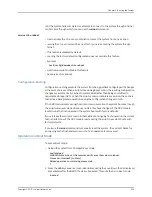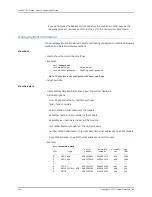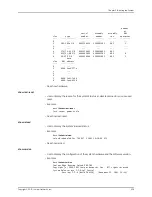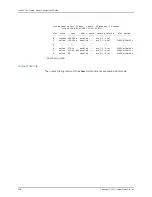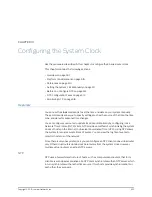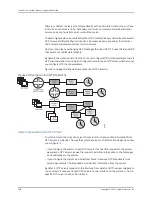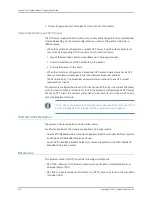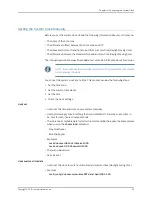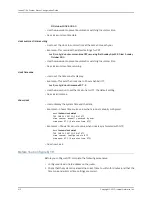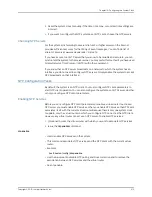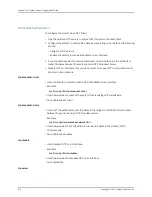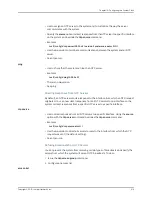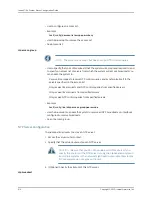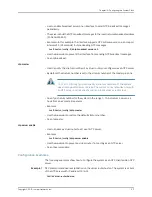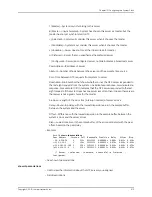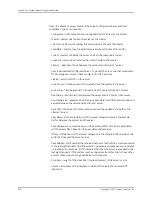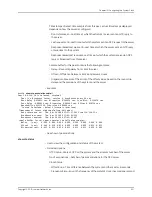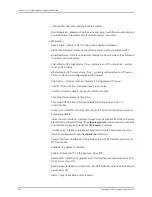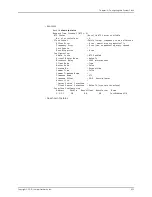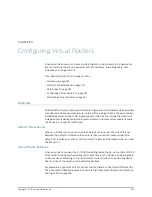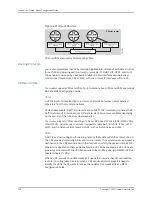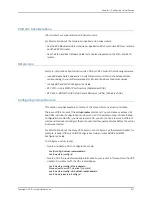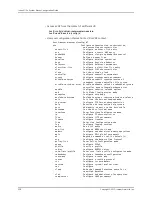
3.
Reset the system clock manually if the time, time zone, or summer time settings are
incorrect.
4.
If you want to configure the NTP system as an NTP client, choose the NTP servers.
Choosing NTP Servers
For the system, synchronizing to several stratum 2 or higher servers on the Internet
provides sufficient accuracy for the timing of event messages. You can find a list of
stratum 2 servers at
www.eecis.udel.edu/~mills/ntp.
If you have access to an NTP server that you know to be reliable and accurate, you can
synchronize the system to that server alone. You may prefer this method if you have used
Simple Network Time Protocol (SNTP) with other equipment.
If you know that an NTP server broadcasts on a network to which the system has an
interface, you do not need to configure NTP servers. Simply enable the system to accept
NTP broadcasts on that interface.
NTP Configuration Tasks
By default, the system is an NTP client. You must configure NTP client parameters to
start NTP client operation. You can also configure the system as an NTP server, whether
or not you configure NTP client parameters.
Enabling NTP Services
Before you can configure NTP client parameters or enable a virtual router to act as an
NTP server, you must enable NTP services. When you enable NTP services, the NTP client
associates itself with the current virtual router. Because there is only one system clock
to update, only the virtual router on which you configure NTP can act as the NTP client.
However, any virtual router can act as an NTP server. To enable NTP services:
1.
(Optional) Access the virtual router with which you want to associate NTP services.
2.
Issue the
ntp enable
command.
ntp enable
•
Use to enable NTP services on the system.
•
This command associates NTP services and the NTP client with the current virtual
router.
•
Example
host1:boston(config)#
ntp enable
•
Use the
no
version to disable NTP polling and clock correction and to remove the
association between NTP services and the virtual router.
•
See ntp enable.
513
Copyright © 2010, Juniper Networks, Inc.
Chapter 10: Configuring the System Clock
Summary of Contents for JUNOSE 11.3
Page 6: ...Copyright 2010 Juniper Networks Inc vi...
Page 8: ...Copyright 2010 Juniper Networks Inc viii JunosE 11 3 x System Basics Configuration Guide...
Page 24: ...Copyright 2010 Juniper Networks Inc xxiv JunosE 11 3 x System Basics Configuration Guide...
Page 32: ...Copyright 2010 Juniper Networks Inc 2 JunosE 11 3 x System Basics Configuration Guide...
Page 146: ...Copyright 2010 Juniper Networks Inc 116 JunosE 11 3 x System Basics Configuration Guide...
Page 166: ...Copyright 2010 Juniper Networks Inc 136 JunosE 11 3 x System Basics Configuration Guide...
Page 432: ...Copyright 2010 Juniper Networks Inc 402 JunosE 11 3 x System Basics Configuration Guide...
Page 488: ...Copyright 2010 Juniper Networks Inc 458 JunosE 11 3 x System Basics Configuration Guide...
Page 524: ...Copyright 2010 Juniper Networks Inc 494 JunosE 11 3 x System Basics Configuration Guide...
Page 554: ...Copyright 2010 Juniper Networks Inc 524 JunosE 11 3 x System Basics Configuration Guide...
Page 566: ...Copyright 2010 Juniper Networks Inc 536 JunosE 11 3 x System Basics Configuration Guide...
Page 588: ...Copyright 2010 Juniper Networks Inc 558 JunosE 11 3 x System Basics Configuration Guide...
Page 613: ...PART 3 Index Index on page 585 583 Copyright 2010 Juniper Networks Inc...
Page 614: ...Copyright 2010 Juniper Networks Inc 584 JunosE 11 3 x System Basics Configuration Guide...
Page 632: ...Copyright 2010 Juniper Networks Inc 602 JunosE 11 3 x System Basics Configuration Guide...





